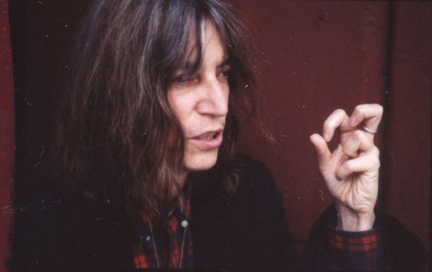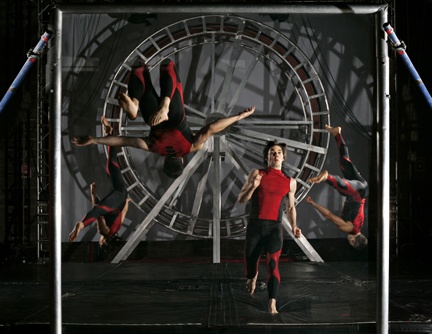Patti Smith and the Dance Group Streb
Institute of Contemporary Art Performances
By: Erica H. Adams - Mar 06, 2007
Two vibrant performances at The Institute of Contemporary Art awakened this blue-state's under-served communities of mind, thirsty for cutting-edge arts, politics and ideas: February 21st,'What New Is' series presented mystic, poet-musician Patti Smith and for the next three nights Streb vs Gravity, Elizabeth Streb's athletic dance troupe that courts danger.
Patti Smith moved in her own air and dust, as if untouched since her landmark album Horses (1975) helped define punk-rock: "three-chord rock merged with the power of the word" she called it "blood pumped into poetry". In fact, her power's grown more resonant. Living at the Chelsea Hotel, in the '70s, with Robert Mapplethorpe, alongside poets Allen Ginsberg, William Burroughs, Gregory Corso and Jim Carroll, poetry was a durable force. Then, Smith asked guitarist Lenny Kaye to plug in; electricity ignited her lyrics. At the height of her fame, in 1979, Smith sidestepped the prevailing stadium rock ethic and moved to Detroit where she continued to write and raised a family with husband Fred "Sonic" Smith, rhythm guitarist for MC5. In March 2007, Smith will be inducted into Rock's Hall of Fame.
At ICA/Boston, Smith brought the audience up-to-date: wry comments established her 'street cred' and she fielded questions from fans that included daughters who brought their mothers. Loss, aging and frailties were directly stated. Her heroes? H.P. Lovecraft, Johnny Appleseed and Ralph Nader! Asked about her photographs at Robert Miller Gallery, she said profits from sales would be donated to JP Community Services, a non-profit building materials resource center. Smith's lineage established, she deftly moved through an incantory shuffle of poems whose raw tenderness and visionary imagery invoked her formative influence, symbolist poet Arthur Rimbaud's Un Saison en Enfer and the free verse of Illuminations. The emotional power of her spoken words or 'talking blues' seared the air when combined with acoustic guitar: she sang of extinction (a Dodo bird) and wailed 'Beneath a Southern Cross' . . . "who grieves not /anyone gone/ to greet lame/ the inspired sky/ amazed to stumble /where gods get lost/ beneath/the southern cross." After Hank William's I'm So Lonesome (I could cry)" the load was lightened by her imitation of Dylan's twang in the refreshingly funny Dog Dreams (1971) about his "bird". From 2004 album Trampin': gleaned from a press clipping of a Belfast tramp's death, she intoned "the hill's were green and/ so were we/we had not known death." In the land where Bling! Bling! rules her 'Radio Baghdad' confronted our remote Iraq war, it began "Shock and awe, Shock and awe/Like some, some Imagined warrior production" and concluded "Suffer not the paralysis of your neighbor /Suffer not but extend your hand." The first day of Spring, when the US began bombing Baghdad, Smith, suffering a migraine, asked a journalist friend in Iraq what happened to the animals and birds just before the bombing, he replied, they were silent; she wrote Birds of Iraq. A validating evening that bridged generations concluded with a homage to William Blake that began "In my Blakean year /I was so disposed /Toward a mission yet unclear" and ended with advice to "Embrace all that you fear /For joy shall conquer all despair /In my Blakean year."
In the lobby, Smith quietly signed copies of her newly released book Auguries of Innocence (2005) the same title Blake used 200 years ago, when he spoke of 'seeing the world in a grain of sand'. Smith slices reality to its core, even from the hallucinatory-real of current U.S. politics. A good time was had by all; the atmosphere was electric.
The extreme "PopAction" dance troupe Streb, founded by Elizabeth Streb in 1985, brought dance into a new arena of dare-devil athleticism and popular entertainment. Testing natural laws of the universe -acceleration, momentum, velocity, mass and speed –underscored a desire to fly and exceed bodily limitations, in the face of danger. More boot camp than Swan Lake, Streb's dancers are trained in ballet, modern dance, martial arts, acrobatics and circus skills.
Men and women share equal or reversible roles. Bodies fall, slam against mats and fly through the air secured in harnesses. Industrial staging included trampolines and a huge half-circle Ferris Wheel-like structure that rocked back–and-forth, nearly toppling over as dancers struggled to keep their balance. Defying danger, Streb's dancers or "method engineers" darted between cement blocks violently thrust across the stage as hung from ceiling. Filmed sequences, electronic sounds and 'cue cards' –"A Body in Motion is Never Alone" –mirrored narratives embodied in physical action. Sounds dancers issued from groans and yelps to shouted directives "Batman and Robin, GO!" or "Back flip!" were exuberant, Pop and real. Jump-cut timing penetrated like a single-line Haiku poem or a three-minute pop tune and sidelined reflection. Titles of the evening's "Action Events" (not dance) recalled comics: Orbit, Crash, Moon, Spin and Tip, then after intermission Air, Gauntlet, Tied. In Revolution, the last work, dancers performed like hamsters jumping across and through an oversized rotating wheel. Injury, dance's dirty little secret was outed by "action architect" Streb's matter-of-fact, closing announcement that one "method engineer" had been injured. Aware her staged 'wild action' is "cathartic" for audiences Streb knows how it "incites the spirit." We know, media's sensationalizing violence has accelerated the rise of violence against women, as well as, in language, business and culture. Mediated violence was re-enacted in Abu-Grav, in gang warfare and Columbine style high school, we know this. Instead of a curtain call, Streb asked the audience to stand up and move through a series of postures that she said explained the different bodily premises of ballet, Merce Cunningham and Streb. A stoic antidote to a couch-potato nation weaned on violence, as a mass cultural barometer, Streb is nothing short of fascinating.
Awarded, in 1997, a MacArthur Foundation "Genius" award, revered choreographer Elizabeth Streb was already was disillusioned with her individual rôle in the arts: traditional dance and the performing arts had, she felt, increasingly failed its audience. Since the federal government cut funding for the National Endowment of the Arts met with little public outcry, Streb thought artists were responsible for the lack of popular support of the arts. In 2003, S.L.A.M. (Streb Laboratory for Action Mechanics) opened in Brooklyn and began her experiment to make art an everyday part of the community and to dissolve the 'fourth wall' between audience and performers. "My goal is nothing short of overhauling the cultural model" Streb said "We need to intersect with everyday lives."






